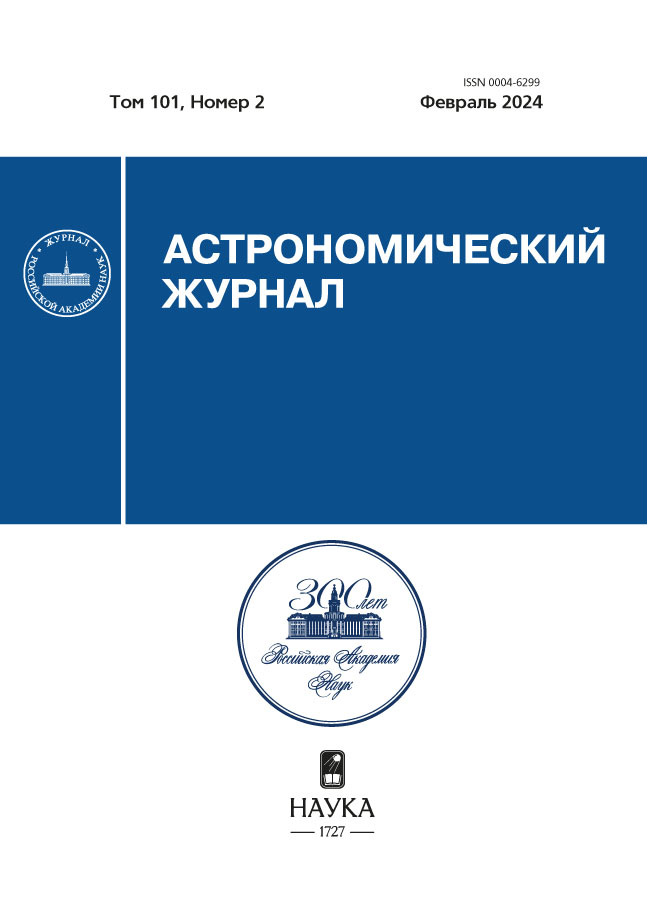Fine frequency structure of interstellar scintillation pattern in radio emission of the PSR B1133+16 at 111 MHz
- Authors: Popov M.V.1, Smirnova T.V.1
-
Affiliations:
- P. N. Lebedev Physical Institute of the Russian Academy of Sciences
- Issue: Vol 101, No 2 (2024)
- Pages: 144-158
- Section: Articles
- URL: https://rjmseer.com/0004-6299/article/view/647615
- DOI: https://doi.org/10.31857/S0004629924020078
- EDN: https://elibrary.ru/KTAEJU
- ID: 647615
Cite item
Abstract
The B1133+16 pulsar was observed at a frequency of 111 MHz with the LPA PRAO radio telescope from October 2022 to March 2023. Observations were made twice a week for two days in a row. In total 38 measurements of the scattering parameters were carried out with a high frequency resolution (up to 65 Hz). We used continuous recording of voltage in the frequency band 2.5 MHz with 8-bit digitization. The signal was reconstructed using the coherent dedispersion method. Dynamic spectra (DSP) were constructed for each observing session. Then, for each DSP, we calculated a two-dimensional autocorrelation function (2DACF) and analyzed its frequency and time sections. We have studied the fine frequency structure of pulsar scintillations by analyzing both the dynamic spectra, and the spectra of individual pulses. It has been found that the intrinsic shape of diffraction distortion on average can be represented by a sharp two-sided function with a characteristic frequency width of 1–2 kHz. The long-term variability of the following parameters has been carefully studied: characteristic scales in frequency and time ( fdif and tdif), and rotation measure RM. Based on the analysis of long-term variations, it is suggested that the true frequency form of scintillations may be distorted by ionospheric effects. We also compared the scintillation parameters separately for the two mean profile components, and no differences between the parameters were found.
Full Text
About the authors
M. V. Popov
P. N. Lebedev Physical Institute of the Russian Academy of Sciences
Email: popov069@asc.rssi.ru
Astrospace Center
Russian Federation, MoscowT. V. Smirnova
P. N. Lebedev Physical Institute of the Russian Academy of Sciences
Author for correspondence.
Email: tania@prao.ru
Pushchino Radio Astronomy Observatory
Russian Federation, PushchinoReferences
- B.J. Rickett, Ann. Rev. Astron. Astrophys. 28, 561 (1990).
- P.A. G. Scheuer, Nature 218(5145), 920 (1968).
- B.J. Rickett, Nature 221( 5176), 158 (1969).
- B.J. Rickett, W. A. Coles, and G. Bourgois, Astron. and Astrophys. 134, 390 (1984).
- B.J. Rickett, Ann. Rev. Astron. Astrophys. 15, 479 (1977).
- J.W. Armstrong, B.J. Rickett, and S.R. Spangler, Astrophys. J. 443, 209 (1995).
- V.I. Shishov and T.V. Smirnova, Astron. Rep. 46(9), 731 (2002).
- V.I. Shishov, T.V. Smirnova, W. Sieber, V.M. Malofeev, et al., Astron. and Astrophys. 404, 557 (2003).
- T.V. Smirnova, V.I. Shishov, W. Sieber, D.R. Stinebring, et al., Astron. and Astrophys. 455(1), 195 (2006).
- W. Lewandowski, M. Kowaliska, and J. Kijak, Monthly Not. Roy. Astron. Soc. 449(2), 1570 (2015).
- R.W. Romani, R. Narayan, and R. Blandford, Monthly Not. Roy. Astron. Soc. 220, 19 (1986).
- D.C. Backer, Astron. and Astrophys. 43(3), 395 (1975).
- J.M. Cordes, J. M. Weisberg, and V. Boriakoff, Astrophys. J. 268, 370 (1983).
- A. Wolszczan and J. M. Cordes, Astrophys. J. Letters 320, L35 (1987).
- Y. Gupta, N. D. R. Bhat, and A. P. Rao, Astrophys. J. 520(1), 173 (1999).
- A.T. Deller, W.M. Goss, W.F. Brisken, S. Chatterjee, et al., Astrophys. J. 875(2), id. 100 (2019).
- R.N. Manchester, G.B. Hobbs, A. Teoh, and N. Hobbs, Astron. J. 129(4), 1993 (2005).
- T.H. Hankins and B.J. Rickett, in Methods in Computational Physics. Radio astronomy 14, 55 (1975).
- I.A. Girin, S.F. Likhachev, A.S. Andrianov, M.S. Burgin, M.V. Popov, A.G. Rudnitskiy, V.A. Soglasnov, V.A. Zuga, Astronomy and Computing 45, id. 100754 (2023), arXiv:2303.17280 [astro-ph.IM].
- R.N. Bracewell, The Fourier Transform and its applications, McGraw-Hill Ser. Electrical Engineering, Networks and Systems (New York: McGraw-Hill, 1986).
- J.M. Cordes, Astrophys. J. 311, 183 (1986).
- J.M. Cordes, J.M. Weisberg, and V. Boriakoff, Astrophys. J. 288, 221 (1985).
- N.D.R. Bhat, A.P. Rao, and Y. Gupta, Astrophys. J. Suppl. Ser. 121(2), 483 (1999).
- N. Bartel, M.S. Burgin, E.N. Fadeev, M.V. Popov, N. Ronaghikhameneh, T.V. Smirnova, and V.A. Soglasnov, Astrophys. J. 941(2), id. 112 (2022).
- M.V. Popov, Astron. Rep. 66(12), 1311 (2022).
- M.V. Popov and T.V. Smirnova, Astron. Rep. 65(11), 1129 (2021).
- W. Feller, An Introduction to Probability Theory and its Applications, Vol. II, 2nd Edition (New York — London — Sydney — Toronto: John Wiley & Sons, Inc., 1971).
- M.V. Popov, N. Bartel, A.S. Andrianov, M.S. Burgin, et al., arXiv:2302.13326 [astro-ph.GA] (2023).
- F.A. Jenet and S. B. Anderson, Publ. Astron. Soc. Pacific 110(754), 1467 (1998).
- M.V. Popov, N. Bartel, M.S. Burgin, C.R. Gwinn, T.V. Smirnova, and V. A. Soglasnov, Astrophys. J. 888(2), id. 57 (2020).
Supplementary files



















